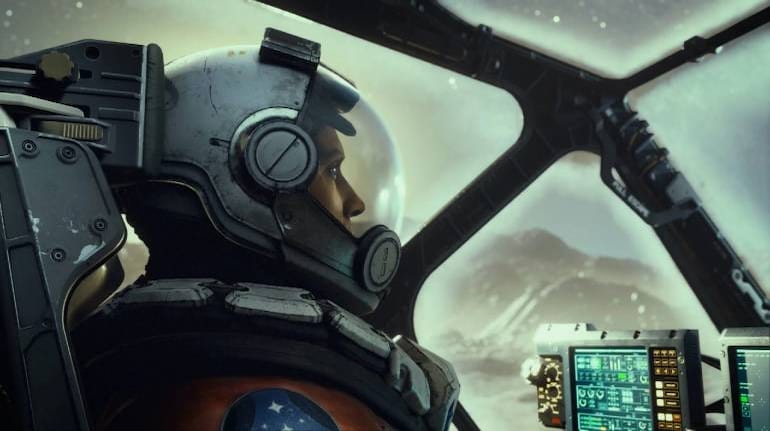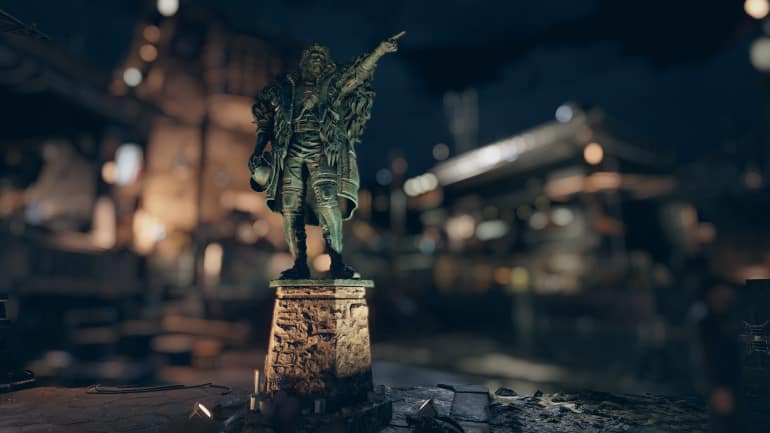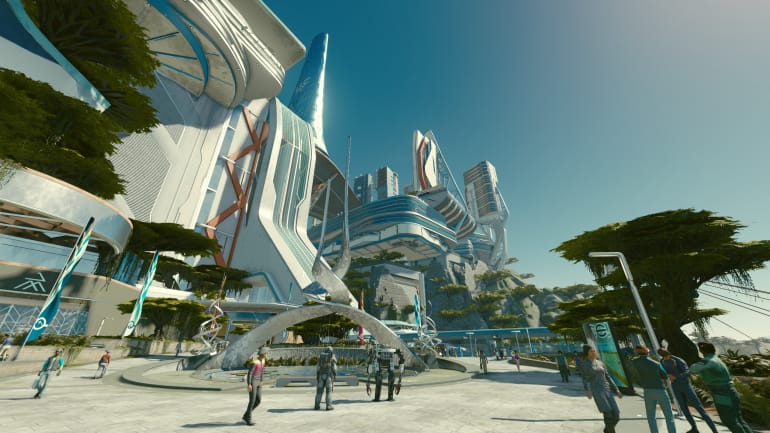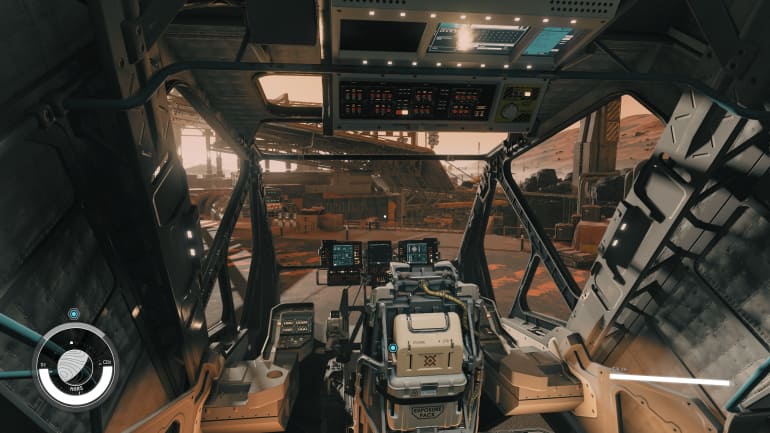



It’s been a while since I last came across a space opera I didn’t enjoy. It’s been a great deal longer since I last enjoyed a Bethesda title.
Both these facts were on a collision course when I set about giving Starfield a whirl over two weeks ago. Now, around 80-odd hours in, I’ve drawn a handful of conclusions that I’m confident won’t be shaken or altered by the time I actually complete the game. And so without further ado, let’s get into it.
 Screengrabs from Starfield captured on Xbox Series XTaking a ride on the hype train
Screengrabs from Starfield captured on Xbox Series XTaking a ride on the hype trainEarly footage, rumours, trailers and extended gameplay footage had me more than mildly curious about Bethesda’s “first new IP in 25 years”. The space combat, traversal, variety of terrain and depth of the shipbuilding mechanics revealed in the leadup to launch were telling me this was going to be more than just Fallout in Space.
I walked into The Elder Scrolls: Morrowind almost two decades ago completely by accident—I had picked up a collector’s edition on sale in a bargain bin somewhere. But since then and as regular as clockwork, I’d found myself disappointed by Bethesda games. I will hasten to point out that Morrowind was by no means a perfect or even exceptional game, buckling as it did under the considerable weight of woefully wooden dialogue, NPCs who make rocks seem lively and terribly clunky combat.
But what it had in spades was atmosphere—an immersive and unique fantasy realm that wasn’t Nordic or Western European—and agency—with almost no guardrails, the game was perfectly content with letting you lock yourself out of plotlines as a result of your own actions.
Neither of the Elder Scrolls titles that followed ever appealed to me in that way again, and the less said about my time with the Fallout titles the better. I guess post-apocalypse and I don’t mix very well. But space operas and I do, which is a major reason why I allowed myself, a PlayStation and Nintendo Switch gamer, to get swept up by the hype. And possibly allowed myself to procure an Xbox Series X to play the damn thing, but that’s a different topic for a different day. The point is that this was one of those rare games on whose hype train I allowed myself a ride. Would I regret the decision? We’ll soon find out.
 Screengrabs from Starfield captured on Xbox Series XFirst impressions
Screengrabs from Starfield captured on Xbox Series XFirst impressionsAt the very start, I’m generally used to either waking up in an underground bunker, in a slave ship or on a prisoner cart in these games, and so, I booted up Starfield expecting more of the same. Unfortunately, the opening was neither as entertaining as Fallout 3’s montage, nor as exciting as the dragon divebombs in The Elder Scrolls: Skyrim, nor even as open-ended as Morrowind’s seemingly uneventful beginning. That was the point at which I pushed all comparisons to the back of my mind, determined as I was to judge Starfield on its own merits or lack thereof.
Following a reasonably detailed character creation suite (complete with various cosmetic options, choice of pronouns, a couple of gaits and a whole host of traits from which to choose) is a humdrum prelude. This, in turn, flows into a very obviously signposted MacGuffin, a very unsubtly shoehorned combat tutorial and a predictable chain of events that positions you as possibly the most important person in the known universe.
It took around three quarters of an hour, or possibly a shade more, before the game was finally willing to unleash me and leave me to my own devices. In terms of graphics, I was far from blown away at this stage with the way Starfield looked. That isn’t to say that the game’s graphics were bad, far from it. Overall, the environments were rich, draw distances were long, and key NPCs were well-rendered. When it came to the texture of water, some trees and a majority of NPCs, I got the distinct feeling I was playing a last-generation game.
Elsewhere, the game is locked at 30 fps on Xbox Series X, and while that might seem unthinkable in this day and age, Starfield appears optimised for the console and I had no complaints about the framerate. On the Dell G16 laptop powered by a GeForce RTX 4060 (currently being reviewed), it’s a different story, with the game capable of providing upward of 60 fps on the lowest graphic setting, and barely 15 fps on the ‘Ultra’ graphic setting. The tradeoff with playing on the lowest setting is that things look a lot like they used to in Half-Life — the 1998 game Half-Life, in case there is any confusion. I found the medium graphic setting to be a compromise I could live with — 40 fps, on average, with reasonably decent visuals.
The main thing I noted about the musical score in the early hour was the end-of-mission flourish that sounds a lot like the one that plays before an announcement in The Hunger Games films. Outside of that, I found the score to be largely understated, and possibly a bit dated.
 Screengrabs from Starfield captured on Xbox Series XNot firing on all engines
Screengrabs from Starfield captured on Xbox Series XNot firing on all enginesI should preface this section by noting that I wasn’t expecting a flawless experience that would elevate gaming for all humankind. My expectations were tempered and being entertained was atop my agenda. Let’s quickly run through the nuts and bolts.
Combat, as with most Bethesda titles in my experience, is rough around the edges. Most enemies (often plagued by suspect AI) tend to be bullet sponges and melee combat is extremely hit-or-miss. In terms of gunplay, in my experience, laser weapons seem to be far more effective than ballistic ones. Additionally, the absence of a proper ‘take cover’ mechanic lends further credibility to the argument that the combat isn’t really up to current-generation standards. Put differently, even the much-maligned Cyberpunk 2077 sported better combat at launch than Starfield does.
This wasn’t a gamebreaker for me since I expected dodgy combat; but I was really looking forward to the space combat. Unfortunately, that ends up being a very dull affair devoid of any finesse or real strategy beyond ‘avoid enemy ships till shields and then engage them’.
Traversal is largely an exercise in tedium, because after a while even bouncing around with your jetpack across miles and miles of terrain gets super tiresome. It’s a relief then that Bethesda saw fit to include several fast travel options to spare you the ennui of repeatedly tracking back and forth over the same areas. However, I would have preferred the option of a ground vehicle (or different types of vehicles) to make terrestrial travel quicker and unarguably more compelling.
Moving on, quest design and dialogue tread very familiar paths. The game includes a variety of RPG mission staples, including detection, subterfuge and espionage, sabotage, negotiation, resource gathering, taking down bandit camps and of course, plenty of fetch quests. And dialogue, while detailed, isn’t particularly open-ended, with conversation choices being either obvious ones or extremely juvenile ones. That conversations don’t take place as cutscenes or within the flow of the game, and instead entail the camera snapping to a tight frame of the interlocutor, looks extremely archaic in 2023.
Structurally too, the game sports some level design that doesn’t really seem to belong in this generation. Imagine if you will, a whole bunch of boxes separated by loading screens, and you’ve got Starfield’s level design. Getting from one box or section of the game to the next requires you to pass through the loading screen. Sure, loading time was only a couple of seconds or so on the Xbox Series and a shade longer on the G16, but it was an annoyance and served to throw me out of my immersion in the world.
Bonus criticism: I found the absence of a codex, journal or diary within which to house all your learnings from your travels quite egregious.
So why then did this clearly flawed and presumably altmodisch game get me hooked the way it did?
 Screengrabs from Starfield captured on Xbox Series XA space parasite
Screengrabs from Starfield captured on Xbox Series XA space parasiteAs the hours ticked by, Starfield began to grow on me. It got to a point where the game had buried itself deep enough in my mind to throw in little cameo appearances in my dreams. Over two weeks of reduced sleep and a non-existent social life later, I’m still going over key moments in my head, wondering ‘what if’, questioning certain decisions and so on. And no, this isn’t because the core gameplay loops suddenly improved overnight.
From around an hour in, I began to notice little hat-tips and references (whether intentional or not) to the likes of Star Trek, the Mass Effect games, The Expanse books and TV show, Orson Scott Card’s Ender's Game and Dan Simmons’ Hyperion, with a tiny sprinkling of Isaac Asimov for flavour. To put it plainly, Starfield isn’t hard sci-fi, preoccupied with scientific logic and accuracy. It is a space opera, and I’m pleased to say, one of the more captivating ones I’ve played since Commander Shepard hung up her boots.
The main story isn’t the most revolutionary, unpredictable or thought-provoking one you’ll ever come across, but it’s perfectly serviceable. After all, anyone who’s ever played a modern RPG will tell you it’s in the side quests and sub stories that you find the magic.
Starfield, like the Bethesda titles that came before it, buries you under side content. And worst of all, it slathers you with layer upon layer of FOMO. For instance, just as you are about to speak to an NPC in order to extract information relating to a mission you’ve been on for the past 45 minutes, a random NPC will pop up teasing a whole different sort of mission. Do you drop the current one and check out just why you’re needed in a drug den? Or do you stay the course?
Fortunately, most of the side quests are very engaging, whether it’s going undercover for a murderous gang of pirates, a stint as a corpo working in a mega-organisation or a frankly ludicrous back-and-forth to figure out why trees are emitting soundwaves. And then there are the random discoveries you make over the course of exploring a planet. Without treading too deep into spoiler territory, stumbling quite arbitrarily upon an abandoned factory was one of the more entertaining digressions Starfield threw my way.
Wandering through the game’s more detailed areas (more on this in the next section) is addictive and filled with all sorts of little surprises. What’s more, it’s been a while since I’ve felt so overwhelmed by my need to do (nearly) every quest in a game.
 Screengrabs from Starfield captured on Xbox Series XWhat really sold me on Starfield
Screengrabs from Starfield captured on Xbox Series XWhat really sold me on StarfieldAny space opera worth its salt must have stunning locations and interesting companions; otherwise, what’s the point? It’s the journey and the company that make the experience, not the destination. Mass Effect 3 is a great example of that adage I’ve pulled out of thin air. So, what does Starfield offer? I’ll admit the prospect of “1,000-plus living, breathing planets” as proclaimed ahead of the launch had me less enthused than the four fully built-out sections of New Atlantis (a capital city), Neon (a cyberpunk hub bathed in fluorescent lights), Akila City (the Wild West, basically) and Cydonia (a near-derelict Total Recall-esque Martian outpost).
A great deal of my time in those cities went into actually exploring their various nooks, crannies and seedy underbellies. Exploring these built-out environments felt far more meaningful to me than sinking time into mining on 1,000 different planets with their own flora and fauna. For that stuff, I’ve got No Man’s Sky sitting in my Game Pass catalogue batting its (naturally, alien) eyelashes seductively at me. I don’t need another version of the same concept.
And then there are your companions. Utterly useless (some truly dodgy AI) in battle for the most part though they may be, it’s their motivations, their banter, their pathos, their side quests and ‘loyalty missions’ that had me truly invested. While you can have up to 20 or so companions on the go, you are expected to assign them to your ship or any outposts you may have built, leave them to hang out at The Lodge (the HQ of the explorers group named Constellation) and take any one along with you on quests. You are well within your rights to travel alone, but where’s the fun in that? Naturally, some of these companions are better written and fleshed-out than others, so you’ll just have to figure out which ones you want around. Individually, it’s hard to pinpoint any one companion who is truly exceptional, but as a collective, they’re as remarkable a bunch of teammates as I’ve seen in videogames that aren’t called Dragon Age.
I’d be lying if I said I wasn’t expecting to enjoy the characters and the locations. However, what truly took me by surprise was how much I grew to enjoy customising and tuning up my ships—of which I had five at last count. My most powerful ship has rendered most space combat an academic exercise, such is its rapier-like ability to obliterate enemy ships. I should point out that I didn't much care for building outposts though.
 Screengrabs from Starfield captured on Xbox Series XVerdict
Screengrabs from Starfield captured on Xbox Series XVerdictStarfield, as I’ve gone to some extent to point out, is a flawed game. It also contains enough jank and bugs to live up to the dubious reputation of other Bethesda titles at launch. However, for the most part, these will be patched, modded and fixed by a combination of developers, modders and assorted members of the online community. And like certain other Bethesda titles, it will be an experience you should not miss. Maybe it’s not a game you should play immediately, but after a few rounds of upgrades and patches.
Ultimately though, what lies beneath all of the unkept promises, lack of frames per second, poor combat, dearth of ground vehicles and weird-looking NPCs is a heartfelt ode to space operas. And that’s worth the price of admission for me.
Game reviewed on Xbox Series X and Dell G16 (13th Gen Intel Core i7-13650HX, NVIDIA GeForce RTX 4060 Laptop GPU and 16 GB RAM). Review code provided by publisher.
Discover the latest Business News, Sensex, and Nifty updates. Obtain Personal Finance insights, tax queries, and expert opinions on Moneycontrol or download the Moneycontrol App to stay updated!
Find the best of Al News in one place, specially curated for you every weekend.
Stay on top of the latest tech trends and biggest startup news.